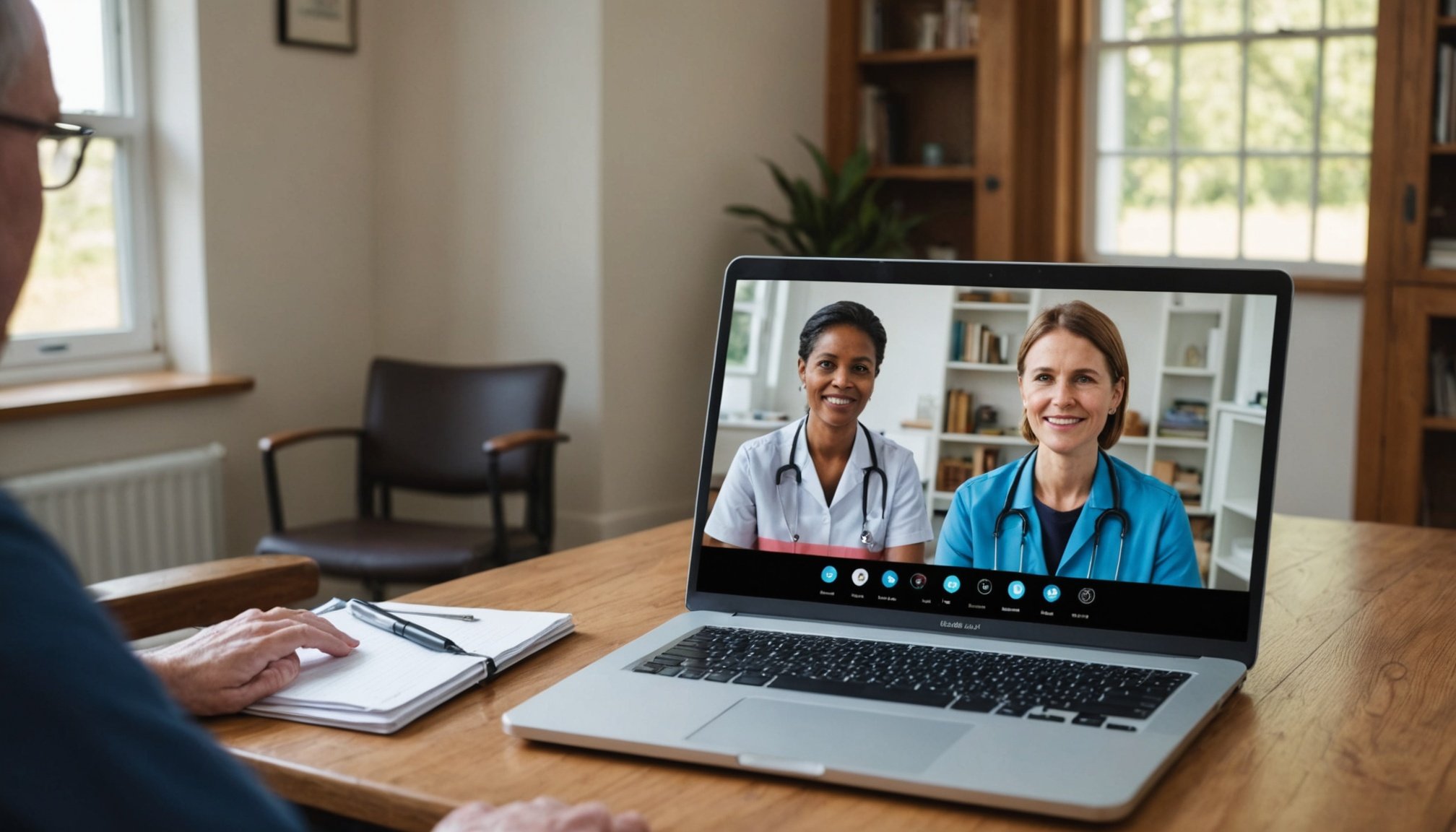Overview of Telehealth in Rural Mental Health
Telehealth has revolutionised access to mental health services, especially in rural communities. By using digital communication tools, it allows patients to consult healthcare professionals remotely. This advancement reduces the need for physical travel, making it easier for people in geographically isolated or underserved areas to access necessary care.
In rural areas, geographical barriers often pose significant challenges to accessing traditional mental health services. The absence of healthcare facilities in these locales exacerbates issues—travel costs and long waiting times may discourage individuals from seeking help. This is where telehealth steps in as a vital solution.
In the same genre : Top Strategies for Effectively Managing Epilepsy in Children: Essential Best Practices
Telehealth addresses these access to care issues by offering a convenient alternative. People can engage in consultations via video calls, which are both time-efficient and cost-effective, reducing the need for long and exhausting travel. Importantly, this method of delivering healthcare has widened the reach of mental health services, playing a crucial role in addressing healthcare disparities that are prevalent in rural areas.
Overall, telehealth enables better access to mental health resources, thus helping bridge the gap between the healthcare availability in urban and rural settings, fostering a more equitable healthcare system for all.
Topic to read : Essential Strategies for Effectively Managing Chronic Migraines in Teens
Benefits of Telehealth for Mental Health Services
Telehealth is transforming mental health services by improving access and patient outcomes. One direct outcome is increased accessibility. Individuals living in remote areas, with limited local services, can now easily consult with mental health professionals through virtual means. This improves overall patient outcomes by ensuring timely interventions.
Another significant benefit is the reduction of travel barriers. Traditionally, receiving mental health care would require patients to travel to clinics, sometimes over long distances. Telehealth eliminates this necessity, making care more accessible, especially for those with mobility issues or tight schedules. The convenience factor helps in keeping appointments and following treatment plans.
Engagement is crucial for effective mental health treatment, and telehealth plays a role in enhancing patient engagement. Remote consultations offer a comfortable environment for clients, facilitating openness and honesty in therapy sessions. Flexibility in scheduling also means patients can choose times that suit them best, reducing stress and promoting consistency in care.
Telehealth fosters continuous care by allowing healthcare providers to monitor progress more frequently. This continuity ensures that issues are addressed promptly, contributing positively to patient outcomes. Overall, telehealth is a cost-effective approach that meets diverse needs in mental health care.
Challenges in Implementing Telehealth
Implementing telehealth comes with its own set of challenges—especially when it comes to overcoming various technology barriers. One of the primary issues is the lack of reliable internet connectivity in rural areas. This technical hurdle can significantly limit access to telehealth services, preventing patients in remote regions from receiving timely medical care. High-speed internet is essential for seamless virtual consultations and data sharing.
Equally concerning are the privacy and security challenges associated with handling sensitive patient data. Patients must trust that their personal health information is secure. Data breaches can erode this trust, hindering the broader adoption of telehealth solutions. Ensuring robust cybersecurity measures is crucial to safeguarding patient confidentiality while leveraging telehealth’s opportunities.
Regulatory issues further complicate the landscape for telehealth implementation. Varying regulatory barriers can impact how telehealth is deployed across different regions. Additionally, reimbursement policies often lack uniformity, creating economic disincentives for healthcare providers to adopt telehealth fully. Navigating these regulatory complexities is essential for making telehealth a viable and sustainable option for medical care. By understanding these telehealth challenges, stakeholders can work collaboratively to develop solutions that bridge these gaps, ensuring more equitable access to healthcare services for all.
Solutions and Best Practices for Telehealth Implementation
Implementing telehealth solutions successfully requires comprehensive strategies and adherence to best practices. These ensure that healthcare providers and patients benefit maximally from the new technology.
Training and Support for Healthcare Providers
Training is crucial for healthcare providers to grasp the functionalities of telehealth tools. Educators must focus on the practical application of these tools in real-world scenarios. Providers could enhance their knowledge of telehealth solutions through workshops, webinars, and peer support groups, helping them to integrate technology into their daily practice seamlessly.
Ensuring Technology Access
Access to technology remains a barrier for many patients. To bridge this gap, healthcare systems should invest in user-friendly devices, ensuring they are affordable and accessible for all demographics. Providing step-by-step guides and customer support can greatly aid patients unfamiliar with digital platforms.
Policy Recommendations
To augment the utilization of telehealth, certain implementation strategies should be advocated as policy recommendations. Governments could standardize procedures and regulations to streamline telehealth services, promoting equitable technology use. Furthermore, financially incentivizing best practices in telehealth can encourage widespread adoption and innovation within this growing field.
Case Studies and Statistics
Examining telehealth case studies provides insight into its transformative impact, especially in rural areas. For instance, one successful program implemented telehealth technology to deliver mental health services in remote communities. As a result, patients experienced reduced travel time and gained easier access to mental health specialists.
Moreover, significant improvements were reported in patient outcomes. In these rural regions, the introduction of telehealth platforms has led to a noteworthy increase in the accessibility of healthcare services. Rural health outcomes have shown measurable progress, with a reported 25% decrease in emergency room visits and a 30% increase in regular check-ups. These statistics highlight the effectiveness of telehealth in bridging the healthcare accessibility gap.
Patient feedback is equally illuminating. Many participants in telehealth programs have expressed satisfaction due to the convenience and efficiency of virtual consultations. Qualitative assessments reveal a recurrent theme of increased comfort and reduced anxiety, as patients benefit from privacy and the convenience of home-based consultations. In essence, these telehealth case studies and emerging mental health statistics underscore how digital innovation positively reshapes healthcare delivery, particularly in underserved areas.
Technologies and Platforms Used in Telehealth
In the rapidly evolving world of healthcare, Telehealth Technology plays a crucial role in connecting patients with providers. Various Digital Platforms and Telemedicine Tools have emerged as essential components for delivering efficient and accessible care.
Video Conferencing Solutions
Video conferencing has become a cornerstone of telehealth, facilitating real-time interactions between patients and healthcare professionals. These Digital Platforms allow for face-to-face consultations, diagnostic discussions, and even mental health therapy sessions. Platforms like Zoom, Microsoft Teams, and Doxy.me are popular choices, valued for their reliability and security features.
Remote Monitoring Tools
Remote monitoring offers unparalleled insights into patient health by utilizing wearable devices and sensors. These Telemedicine Tools collect data on vital signs, activity levels, and more, allowing providers to track and manage patient conditions remotely. Such solutions are particularly beneficial in managing chronic illnesses and mental health, providing continuous, real-time data that can alert healthcare professionals to any concerning changes.
Patient Management Software
Telehealth Technology is further enhanced by integrating Patient Management Software. These systems streamline the process of scheduling, billing, and managing patient records. Software such as Epic and Cerner ensure that all patient interactions are seamlessly coordinated, improving the overall efficiency of healthcare delivery.











